The Flora
Afton Villa Gardens serves as both a horticultural delight and a historical treasure, offering a serene escape for those seeking natural beauty and a connection to the cultural heritage of Louisiana. Whether strolling along winding pathways or admiring the blooming flowers, visitors are immersed in a timeless and captivating atmosphere at Afton Villa Gardens.
Select Plant: Azaleas | Tulips | Daffodils | Spirea | Camellia | Wisteria | Fox Glove | Larkspur | Delphiniums | Annuals & Perennials
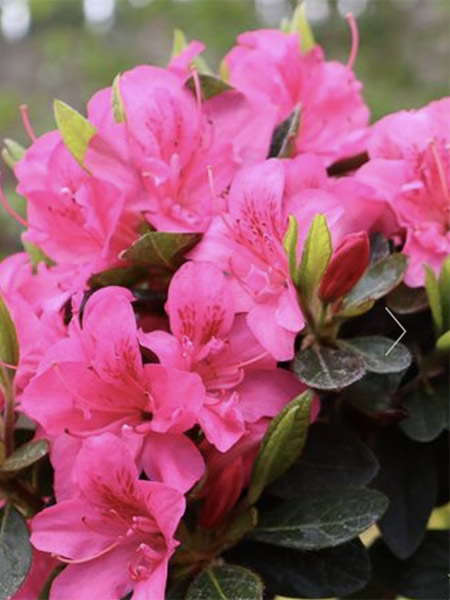
Azaleas
Azaleas are a diverse and colorful genus of flowering shrubs belonging to the Rhododendron family. Known for their vibrant and often fragrant blooms, azaleas come in a wide range of hues, including shades of pink, purple, red, and white. These deciduous or evergreen shrubs are prized in landscaping for their ability to add a burst of color to gardens, borders, and woodland areas. Azaleas typically flower in spring, producing clusters of trumpet-shaped blossoms that create a visually stunning display. They thrive in acidic soil and are popular choices for gardens in temperate climates, requiring proper care and attention to maintain their health and vibrant appearance.
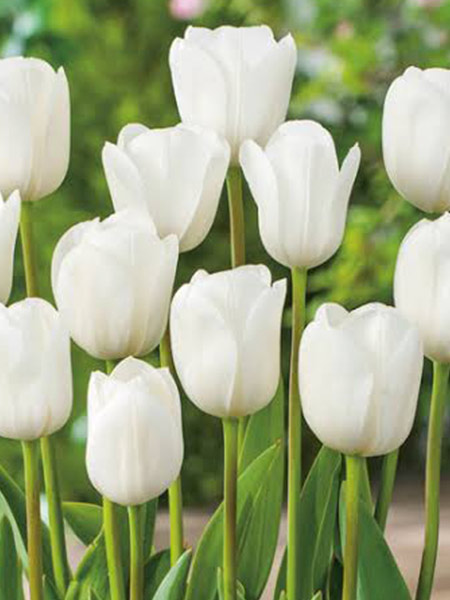
Tulips
Tulips are iconic spring-blooming flowers that belong to the Liliaceae family. Native to Central Asia, these bulbous plants are widely cultivated for their distinctive cup-shaped blossoms and vibrant colors, ranging from brilliant reds and pinks to soft yellows, whites, and purples. Tulips come in various shapes, including single, double, and fringed, adding to their visual diversity. They have a straightforward yet elegant appearance, with a single stem topped by a solitary flower. A symbol of love and springtime renewal, tulips are often associated with the Netherlands, where they have become a cultural emblem. They are a popular choice for gardens, flower beds, and floral arrangements, providing a delightful burst of color and charm during the early months of the year.

Daffodils
Daffodils, members of the Narcissus genus, are perennial flowers cherished for their cheerful and vibrant presence in spring gardens. Native to Europe and North Africa, these bulbous plants are recognized for their distinct trumpet-shaped flowers that bloom in a variety of hues, including yellow, white, and orange. Daffodils symbolize renewal and the arrival of spring, often heralding the end of winter with their nodding blossoms and slender, green stems. They thrive in well-drained soil and sunlight, making them a popular choice for both garden borders and containers. Daffodils are low-maintenance, naturalize easily, and can be found in diverse cultivars, contributing to their enduring popularity as one of the early bloomers that bring joy to gardens and landscapes.
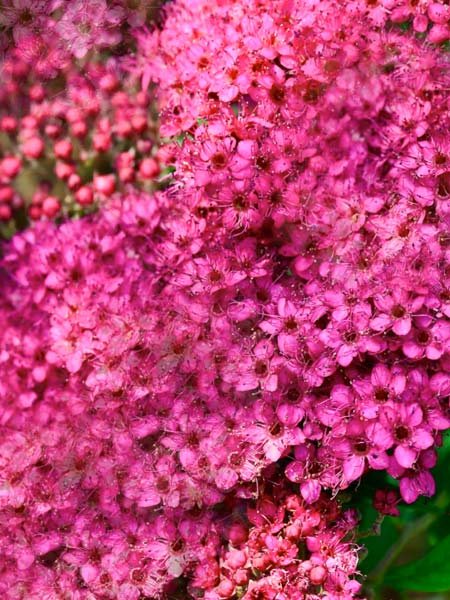
Spirea
Spirea, also known as Spiraea, is a genus of deciduous shrubs native to temperate regions of the Northern Hemisphere. These ornamental plants are cherished for their delicate clusters of small, colorful flowers that bloom in spring and summer, adorning gardens with bursts of pink, white, or red hues. Spirea bushes typically have arching branches adorned with serrated leaves, adding to their aesthetic appeal. They are versatile additions to landscapes, suitable for borders, hedges, or as standalone specimens. With various cultivars available, ranging in size and flower color, spirea offers options to suit diverse gardening preferences. Additionally, their hardiness and ease of care make them popular choices for both novice and experienced gardeners alike.

Camellia
Camellia, a beloved flowering shrub native to East Asia, particularly China and Japan, is celebrated for its exquisite blooms and glossy, dark green foliage. With over 200 species, camellias come in a variety of shapes, sizes, and colors, ranging from delicate white to vibrant pink and red hues. These evergreen plants typically bloom from late winter to early spring, providing a burst of color when the garden is most in need of cheer. Camellia flowers are characterized by their perfectly symmetrical petals and often feature prominent yellow stamens at their center. They are prized for their versatility in the landscape, serving as striking specimens, elegant hedges, or even as espalier against walls. Camellias are also valued for their cultural significance, with some varieties holding symbolic meanings of love, devotion, and longevity. With proper care camellias can thrive for generations, adding timeless beauty to gardens around the world.
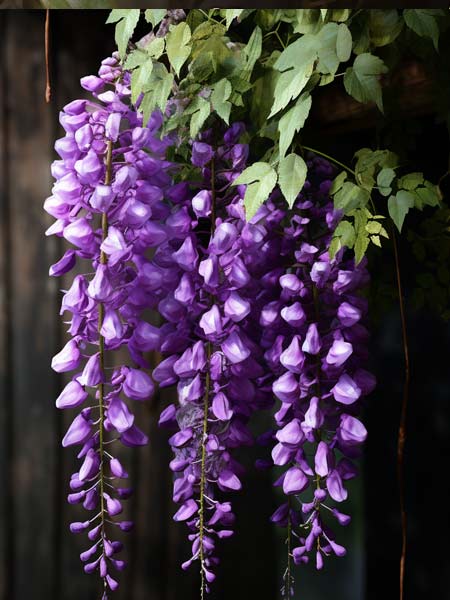
Wisteria
Wisteria is a breathtaking flowering vine renowned for its cascading clusters of fragrant, lavender, blue, or white blossoms that adorn arbors, pergolas, and trellises in spring and early summer. Native to East Asia, particularly China, Japan, and Korea, wisteria vines are prized for their vigorous growth and ability to cover large areas with lush foliage and beautiful blooms. Its twining stems and pinnate leaves create an enchanting backdrop for the stunning pendulous flowers, which often hang in long, graceful racemes. Wisteria is a symbol of romance and elegance, evoking a sense of tranquility and beauty wherever it grows. However, it’s worth noting that wisteria can be invasive in certain environments, so proper pruning and maintenance are essential to keep it in check while enjoying its spectacular display.

Foxglove
Foxglove, scientifically known as Digitalis, is a captivating biennial or perennial plant that graces gardens and woodland areas with its tall spires of tubular flowers. Native to Europe, North America, and parts of Asia, foxglove is distinguished by its striking blooms that range in color from shades of pink, purple, white, and occasionally yellow. Each flower sports distinct spots or speckles within its throat, adding to its allure. While admired for its beauty, foxglove contains potent cardiac glycosides, making it poisonous if ingested. Despite its toxicity, foxglove has been historically used in medicine for heart conditions, although extreme caution must be exercised. In the garden, foxglove adds vertical interest and a touch of wild elegance, attracting pollinators such as bees and hummingbirds.
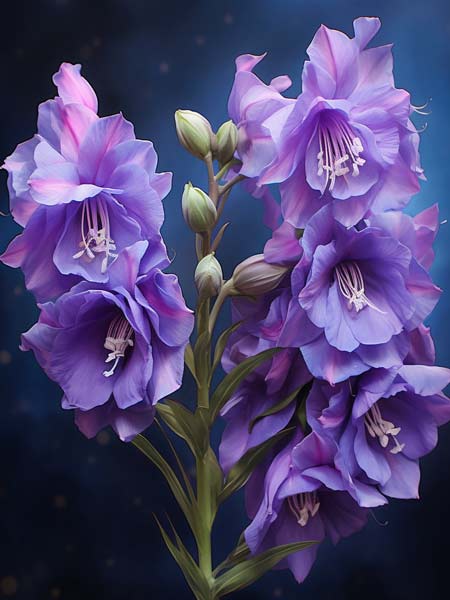
Larkspur
Larkspur, scientifically known as Delphinium, is a stunning flowering plant cherished for its tall spikes adorned with colorful blooms. Belonging to the buttercup family Ranunculaceae, larkspur is primarily known for its delicate, spurred flowers that range in hues from vibrant blues and purples to soft pinks and whites. These flowers typically bloom in late spring to early summer, attracting pollinators such as bees and butterflies. Larkspur is a popular choice for garden borders, cottage gardens, and cutting gardens due to its elegant appearance and long-lasting cut flowers. However, it’s important to note that while larkspur adds beauty to outdoor spaces, all parts of the plant contain toxins and should be handled with care.

Delphiniums
Delphiniums are stunning perennials known for their tall spikes adorned with colorful, spurred flowers that resemble playful dolphins leaping from the sea, hence their name. These enchanting blooms come in various shades of blue, purple, pink, and white, adding a touch of elegance and charm to any garden. Delphiniums are popular for their towering presence, often reaching heights of up to six feet, making them ideal for creating dramatic focal points or backdrops in flower beds and borders. With proper care and well-drained soil, these majestic flowers thrive in sunny locations, attracting butterflies and hummingbirds while providing a delightful display of color throughout the summer months.
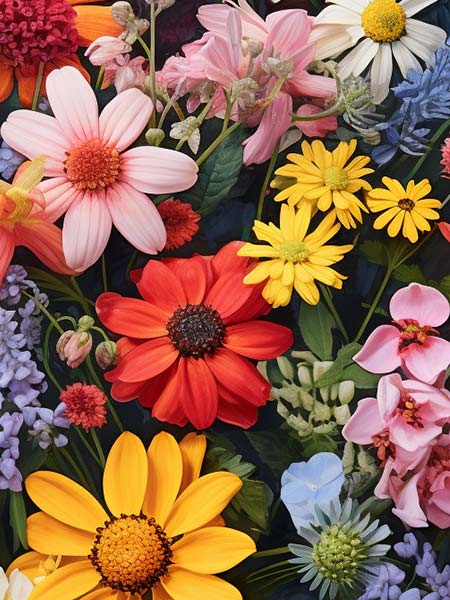
Annuals and perennials
Annuals and perennials are two categories of plants distinguished by their lifespans and growth habits. Annuals complete their life cycle within a single growing season, typically germinating, flowering, and producing seeds before dying off. These plants often provide vibrant bursts of color and are favored for their ability to quickly fill garden spaces. Perennials, on the other hand, regrow each year from the same roots, persisting through multiple growing seasons. They often offer a more permanent presence in gardens, returning reliably year after year. Perennials encompass a wide range of plant types, from flowering shrubs to herbaceous perennials like grasses and flowers. Gardeners often combine both annuals and perennials to create dynamic and long-lasting landscapes.
Here is a guide to the blooming season for some of our favorite varieties…

More Info: Azaleas | Tulips | Daffodils | Spirea | Camellia | Wisteria | Fox Glove | Larkspur | Delphiniums | Annuals & Perennials